Day 2 of a two day Private Tour today, and the plan was to look for some more of the rarities and scarce winter birds which hadn’t yet managed to catch up with.
As we made our way down to the coast, we saw two Barn Owls out hunting. It had been wet overnight and they were probably making the most of the dry morning to try to feed. We headed for Holkham first and parked by the gates to Holkham Park. As we walked down towards the lake, another Barn Owl was flying back and forth through the trees. It is typical parkland in here, with the trees widely spaced and with rough grass below, a perfect sheltered place in which to hunt. It was quite magical to watch, working its way silently in and out of the trees.
Down at the edge of the lake, we could see one of the 1st winter drake Scaup away to the left, with a raft of Tufted Duck, but we had really come to look for the Ferruginous Duck and Ferruginous Duck hybrid, so we left the Scaup for later and turned the other way. We didn’t have to walk too much further before we found them. First we picked up the female Ferruginous Duck, in amongst the Pochards – smaller than a Pochard, and a rich chestnut brown, unlike the colour of any of the other ducks, with a striking white patch under the tail.
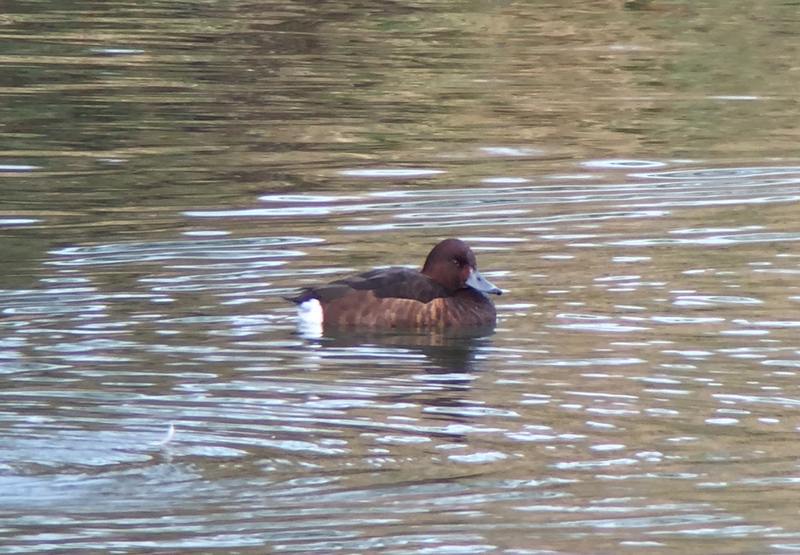 Ferruginous Duck – the female was on the lake again today
Ferruginous Duck – the female was on the lake again today
Ferruginous Duck – some video from a couple of days ago
The Ferruginous Duck swam a little further along and the next thing we knew the drake Ferruginous Duck x Pochard hybrid was swimming alongside it. The hybird is arguably a smarter bird than the Ferruginous Duck, a bit like a Pochard but with more brown tones instead of the grey and black, a rich chestnut head and almost purple-toned breast, subtly vermiculated grey-brown flanks and back and a poorly marked small white patch under the tail. A real stunner!
 Ferruginous Duck x Pochard hybrid – a very smart drake
Ferruginous Duck x Pochard hybrid – a very smart drake
Ferruginous Duck x Pochard hybrid – some video from today
It was nice to see these ducks, and also the large numbers of Pochards and Tufted Ducks on the lake, but with some rare ducks you always have to wonder about their origins, and Ferruginous Ducks are very commonly kept in captivity. Unfortunately, the presence of a hybrid and Ferruginous Duck together just add to those suspicions.
After watching the two ducks for a while, we walked down to where we had seen the Scaup earlier, but there was no sign of it at that end of the lake. There were also fewer Tufted Ducks there. It could easily have flown past us while we were focused on the others, so we walked back up past the Ferruginous Duck and hybrid to the far north end of the lake, which is more sheltered. Sure enough, there were all the Tufted Ducks and in amongst them were the two 1st winter drake Scaup, easily distinguished from a distance by their grey backs, the presence of retained brown feathers in their flanks pointed to their young age.
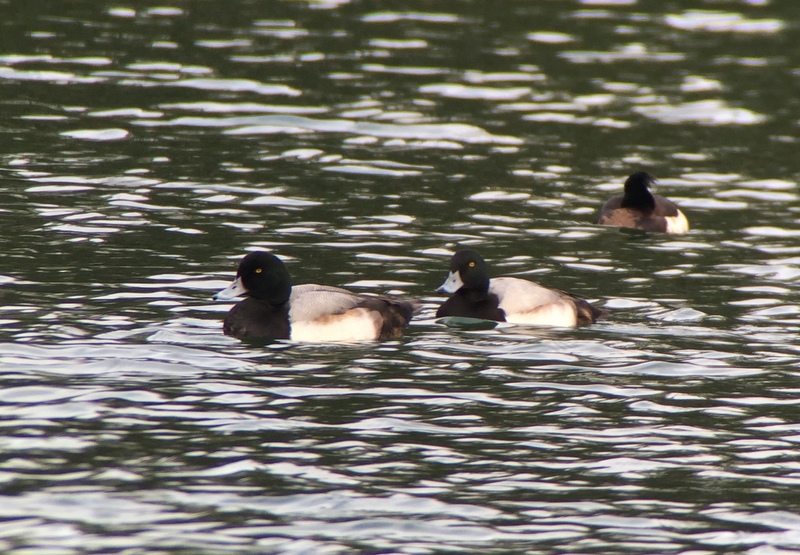 Scaup – two first winter drakes
Scaup – two first winter drakes
That was a great start to the day, so we set off out back to the car with a spring in our step. We drove west from Holkham – past yet another Barn Owl by the road, our fourth of the morning. The very pale Common Buzzard, often mistaken for a Rough-legged Buzzard by the unwary, was perched in one of its usual trees north of the road. We went as far as Burnham Overy Staithe and parked in the car park by the harbour.
The tide was out as we walked out. Most of the local Brent Geese were out in the harbour channel, bathing and preening. We had a quick look through them, but couldn’t see anything different before they started to fly off in small groups to the grazing marshes. There were plenty of waders out on the mud too, Black-tailed and Bar-tailed Godwits, Grey Plover, Redshank and Dunlin. A single solitary Knot was there too.
It was a bit windy and exposed up on the seawall this morning, so we got our heads down and made for the beach. It was not much better out there, and we turned straight into the west wind and strode out towards Gun Hill. There were lots of waders around the pools on the beach, a large group of silvery grey and white Sanderling, with a few much darker Turnstone in amongst them. But there was nothing at first along the tideline.
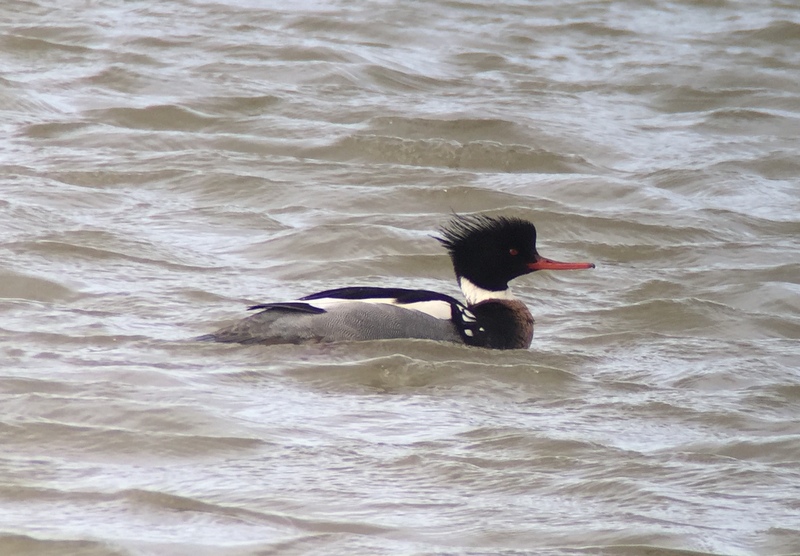 Red-breasted Merganser – a smart drake off Gun Hill
Red-breasted Merganser – a smart drake off Gun Hill
As we got closer to the end of the beach, we started to see several Red-breasted Mergansers in the harbour channel. Down at the point, we walked very slowly along the tideline trying not to flush the Shore Larks, but they didn’t seem to be there at first. As more Red-breasted Mergansers swam out from the edge of the channel at the end, below the beach, a smaller bird swam out with them, a Slavonian Grebe. The Mergansers were spooked by our sudden appearance and they all took off, but thankfully the Slavonian Grebe landed again only a little further out in the middle of the channel. We got a great look at it through the scope.
 Slavonian Grebe – in the channel between Gun Hill & Scolt Head
Slavonian Grebe – in the channel between Gun Hill & Scolt Head
We looked up from our scopes and noticed some movement on the beach, not twenty feet in front of us. There were the three Shore Larks, creeping about unobtrusively on the grass and seedheads piled up on the high tide line. We quickly turned the scopes on them and got unbelievably close views as they fed quietly, picking at the dead vegetation. Such stunning birds, just here for the winter from the Scandinavian tundra, and so tame they probably hadn’t seen many humans before they came here.
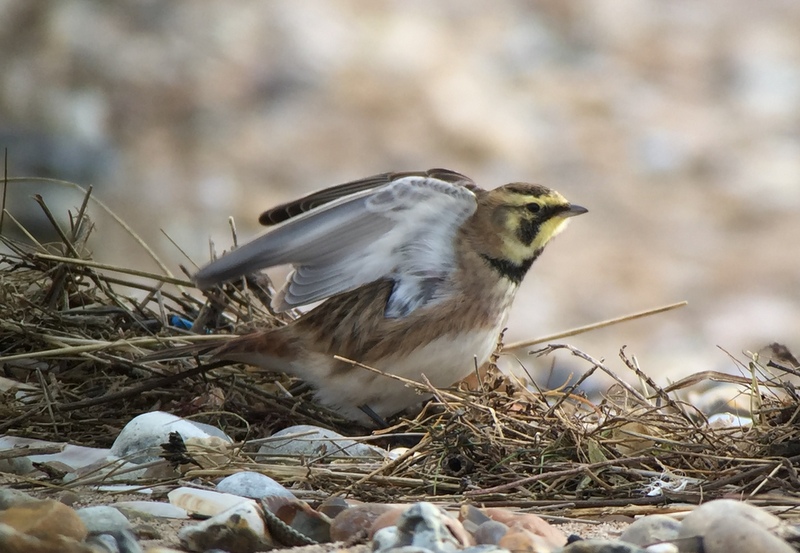 Shore Lark – the three were still on the beach at Gun Hill
Shore Lark – the three were still on the beach at Gun Hill
 Shore Lark -showing the small black ‘horns’ on its head
Shore Lark -showing the small black ‘horns’ on its head
As we walked back, the sun had come out and the wind was at our backs – having enjoyed such amazing views of the Shore Larks, the walk went much more quickly. It was all the sweeter after the frustration of yesterday – when the Shore Larks at Holme flew off before we could see them.
Back on the seawall, we stopped to scan through the geese again, that were all feeding out on the grazing marshes. Unfortunately, most of the Brent Geese were way over the back, beyond the reeds. The smaller group which was closer to us did contain six Barnacle Geese, though presumably feral ones from Holkham Park. Then a Marsh Harrier drifted over and everything took flight. The waders went up first – Curlews, Lapwings, Golden Plover – and panicked the geese too. Fortuitously, a lot of the geese landed again much closer, and in the small group right in front of us we managed to find the one we were looking for, the Black Brant x Dark-bellied Brent Goose hybrid which is usually to be found here. Not quite dark enough for a true Black Brant, it shows grey tones in the belly and upperparts like one of our normal Dark-bellied Brent Geese, but has a much more prominent white flank patch and a very strongly marked white collar.
 Black Brant x Dark-bellied Brent hybrid – at Burnham Overy, as usual
Black Brant x Dark-bellied Brent hybrid – at Burnham Overy, as usual
We got back to the car and headed back east along the coast road. We made a quick stop by the road at Holkham, to see the White-fronted Geese. They were a bit distant today, grazing over on the old fort. We were just packing up to leave when a very large white bird took off from the reeds out on the grazing marshes. There was no mistaking it, it was so big – we have seen the Great White Egret here several times over the last month or so, but it is often elusive and can be tucked down out of view, so it was good to see it today. It landed on the edge of a pool briefly, where we could get it in the scope, before walking back into the reeds.
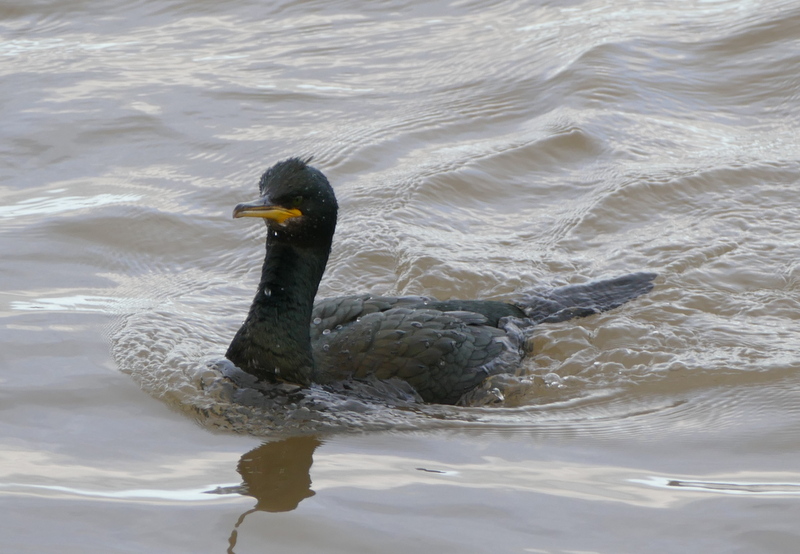 Shag – came swimming in as we arrived
Shag – came swimming in as we arrived
We carried on east and took a quick diversion through the middle of Wells, stopping briefly in the car park on the quay. We hadn’t even got out of the car and we could see the Shag which has taken up semi-residence here for the winter swimming towards us. It made straight for the pontoons to which the boats moor and climbed up using one of the tyres attached to the side. This is its favourite place when it is in attendance, and it perched there obligingly, spreading its wings to dry and preening. Up close, we could see the beautiful green and bronze sheen on its black feathers.
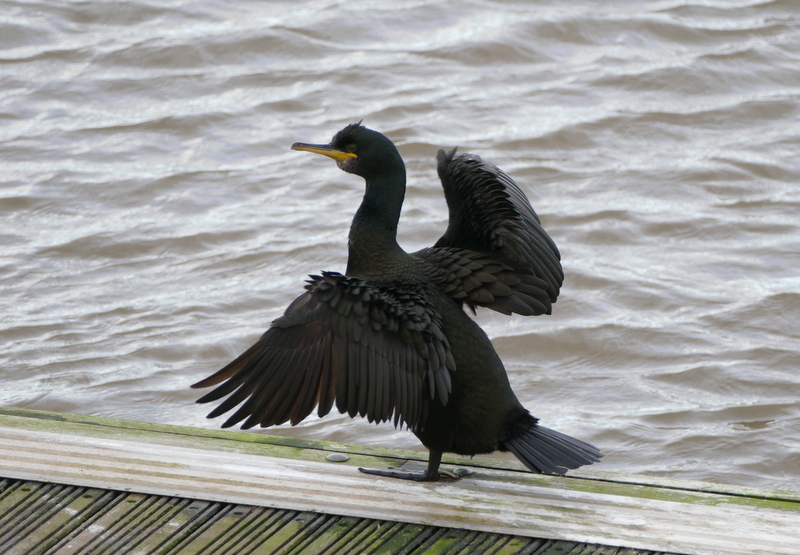 Shag – perched in its usual spot, drying its wings
Shag – perched in its usual spot, drying its wings
Our next stop was at Blakeney. We had a quick stop for lunch, overlooking the harbour channel. Down in the water was a large gull, about the size of a Herring Gull but with a curiously dark grey back. It was not dark enough for a Lesser Black-backed Gull and had strange fleshy-coloured legs, rather than yellow. Luckily, we have seen this individual several times here over the last couple of months, so we didn’t spend too long puzzling over it. It seems to be most likely a Herring Gull x Lesser Black-backed Gull hybrid. Gulls are just as bad as wildfowl at hybridising – and we seemed to be having a day of hybrids today.
Afterwards, we walked out along the seawall. A male Stonechat was feeding along the edge of the saltmarsh, dropping down to the base of the seawall to pick at the accumulated plant debris left by the tide. A Barn Owl flew out across the grass, already out hunting again for the afternoon, making the most of the brighter weather. The wind had dropped considerably too.
We had really come to look for the Lapland Buntings, but we knew that they had become increasingly hard to see well in recent weeks. They seem to spend most of their time out in the tallest vegetation. Still, we felt confident as we walked out. There was no sign of them when we first arrived, but we didn’t have to wait long before suddenly all the Skylarks took off from the tall grass at the back. We heard a Lapland Bunting call first, a dry rattling ‘pt-t-t-t’, and then picked one out amongst the Skylarks as they flew off overhead, slightly smaller and with a heavier front end. Thankfully we saw where it landed and it was over right by the fence.
We walked round and approached very gingerly. At first we could just see a Skylark in the grass just behind the fence, but then we saw a Lapland Bunting a little further along. We just got it in the scope and had time to have a quick look at it before it crept away through the grass and into the taller dead weeds beyond. It felt like that might be the best we would get, but at least it was better than just seeing and hearing them in flight. Then someone walked along the path from the other direction and all the Skylarks and at least two Lapland Buntings took off again.
They flew round for some time, and one of the Lapland Buntings circled round in front of us a couple of times, looking like it might land back in the denser vegetation again. But this time it turned towards the seawall and dropped down in the short grass. We lined the scopes up and realised we were looking at two different birds, both out in the open. One of the Lapland Buntings flew off again, but the other remained where it was. It stood for a couple of minutes out in the open, looking round, before starting to feed – we got an amazingly long look at it. We could then see it creeping around in the short grass, before it gradually worked its way in deeper out of view. Wow!
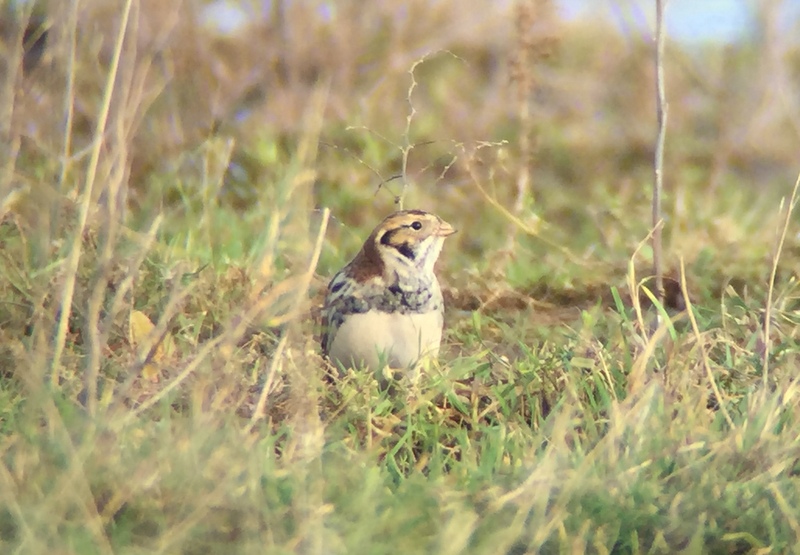 Lapland Bunting – showed amazingly well this afternoon
Lapland Bunting – showed amazingly well this afternoon
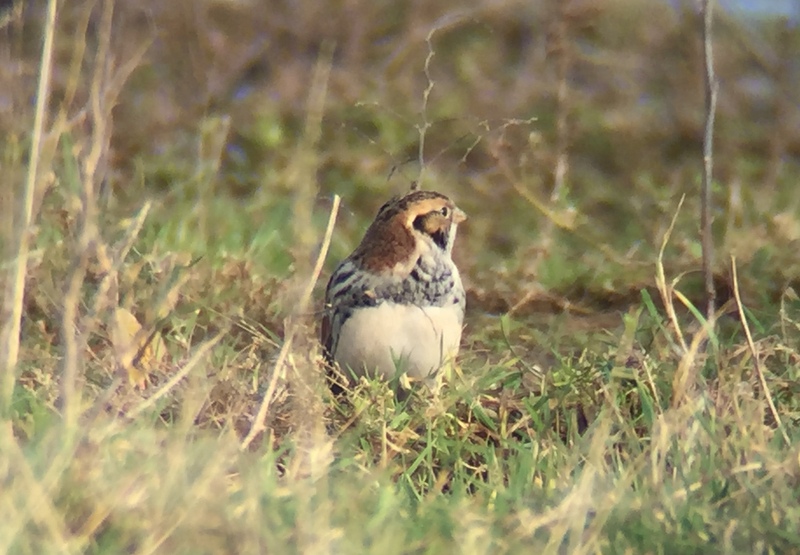 Lapland Bunting – showing its rusty-brown nape
Lapland Bunting – showing its rusty-brown nape
Lapland Bunting – a very short video clip from today
That had been far more successful that we had imagined and we didn’t have to wait long either, so we had time to spare. We decided to drive round to Cley and down to the beach. There was a possible American Golden Plover reported yesterday in the Eye Field. There had been no mention of it today, so presumably whatever it was could not be found, but we though we would have a look anyway. There were several birds down in the grass, but they were all our normal Eurasian Golden Plovers.
We had a quick look out to sea from here. There was a trickle of Red-throated Divers flying west offshore and a couple of distant auks. A single Guillemot dropped in on the sea, but it was a long way out and impossible to pick up on the water. We decided to move on.
We turned inland and drove through farmland behind the coast to a set of old farm buildings. On the way, yet another Barn Owl flew across the road – we drove alongside it slowly, as it flew along the other side of a hedge, then it flew up and across the road right in front of us. This is a reliable site for Little Owl, but we don’t normally go looking for them in the late afternoon. Fortunately, one was perched up out of the wind in an old broken window when we arrived and we got a great look at it in the scope, fluffed up.
We turned around and headed back down towards the coast. As we did so, we could see a large flock of Brent Geese flying up in the distance and heading inland. We followed them but unfortunately they dropped down out of sight behind a line of trees. While we were trying to find an angle to view them from, the farmer came out and flushed them so that was that.
We drove round to Stiffkey Fen to finish the day. As we walked along the path by the road, a ringtail Hen Harrier was circling over the river valley beyond. The river level was very high, but the path down towards the seawall was clear. On the way, we stopped to look out across the Fen. The water level has finally dropped a little and there is now some mud showing again. Most of it was occupied with the local Greylag Geese and a mass of Lapwings, but in amongst the latter in the shallow water was a paler wader, a single Greenshank.
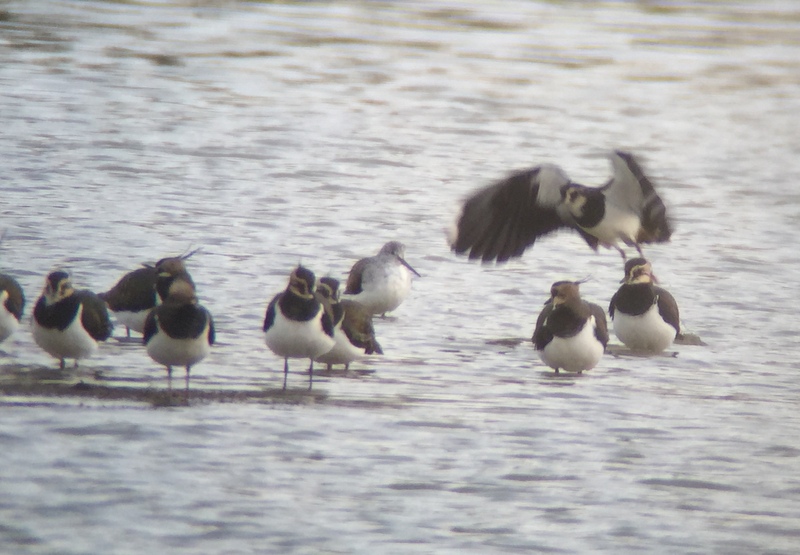 Greenshank – in with the Lapwings on Stiffkey Fen
Greenshank – in with the Lapwings on Stiffkey Fen
We had hoped to look for the Black Brant here today, but most of the Brent Geese had headed off inland – further groups flew over our heads as we were walking out. A small group of Brent Geese dropped in to the Fen to bathe, but it was not among them. We walked out to the seawall and round to the boats to look out across Blakeney Harbour. The blackthorn by the seawall was a mass of blossom – spring must be just around the corner!
There were plenty of Red-breasted Merganser and Goldeneye out in the harbour, but no sign of the Great Northern Divers. The tide was high and the area off the Point was very rough, so perhaps they had gone out to sea. Lots of gulls were starting to fly in from all directions, mostly Common Gulls and Black-headed Gulls and drop down onto the remaining mud or out on the water before going to roost.
It was unfortunately time for us to call an end to the day as well, but what a day, or couple of days, it had been!
 Blackthorn blossom – spring must be almost here
Blackthorn blossom – spring must be almost here
















